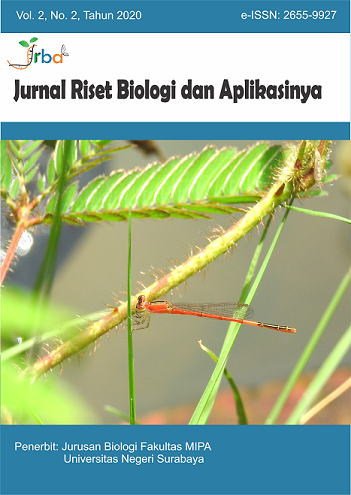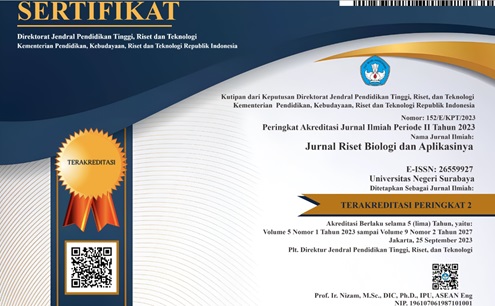Analysis Condition of Coral Reef Covering in Pramuka Island Waters, Seribu Islands using Line Intercept Transect (LIT) Method
DOI:
https://doi.org/10.26740/jrba.v2n2.p77-81Keywords:
Coral reef, Line Intercept Transect, seribu islandsAbstract
The coral reef ecosystem is one of the typical tropical ecosystems with high biodiversity which has an important role both biologically, ecologically, physically as well as socially and economically. Several coral reef areas in Indonesia were reported to have suffered damage, not only due to climate change which has an impact on rising sea surface temperatures and ocean acidification but also due to anthropogenic factors and irresponsible management of marine tourism. This study aimed to analyze the condition of coral reefs based on covering in Pramuka Island, which is one of the famous tourist destinations in the Seribu Islands. The study was conducted using Line Intercept Transect (LIT) method at predetermined coordinate points. The results showed that the dominant coral reef life form was Acropora Submassive (ACS), namely 18.9%, and Acropora Branching (ACB) as much as 12.48%. Besides, the types of life forms found were coral foliase (9.42%), Miliepora Coral (9.2%), Coral Massive (4.8%), Acropora Encrustring (4.24%), and so on. Based on the results of this study, it can be concluded that the condition of coral reefs in Pramuka Island is still relatively good with a total coral cover percentage of 72.38%. Efforts to protect the coral reef ecosystem in this area need to be considered so that its condition can be maintained.
References
Adriman, Purbayanto, A., Budiharso, S., & Damar, A. (2013). Pengaruh Sedimentasi Terhadap Terumbu Karang di Kawasan Konservasi Laut Daerah Bintan Timur Kepulauan Riau. Berkala Perikanan Terubuk, 41(1), 90101.https://doi.org/http://dx.doi.org/10.31258/terubuk.41.1.90-101.
Baker, A. C., Glynn, P. W., & Riegl, B. (2008). Climate change and coral reef bleaching: An ecological assessment of long-term impacts, recovery trends and future outlook. Estuarine, coastal and shelf science, 80(4),435-471. https://doi.org/10.1016/j.ecss.2008.09.003.
Biggs, D. (2011). Understanding resilience in a vulnerable industry: The case of reef Tourism in Australia. Ecology and Society, 16(1). https://doi.org/10.5751/ES-03948-160130
Clifton, J. (2009). Science, funding and participation: Key issues for marine protected area networks and the Coral Triangle Initiative. Environmental Conservation, 36(2), 9196. https://doi.org/10.1017/S0376892909990075.
Dahuri, R. (2000). Kebijakan dan strategi pengelolaan terumbu karang Indonesia. Prosiding pengelolaan dan IPTEK terumbu karang Indonesia, 1-16.
Daniel, D., & Santosa, L. W. (2014). Karakteristik Oseanografis dan Pengaruhnya Terhadap Distribusi dan Tutupan Terumbu Karang di Wilayah Gugusan Pulau Pari, Kabupaten Kep. Seribu, DKI Jakarta. Jurnal Bumi Indonesia, 3(2). http://lib.geo.ugm.ac.id/ojs/index.php/jbi/article/view/594/567
Edinger, E. N., Jompa, J., Limmon, G. V., Widjatmoko, W., & Risk, M. J. (1998). Reef degradation and coral biodiversity in Indonesia: Effects of land-based pollution, destructive fishing practices and changes over time. Marine Pollution Bulletin, 36(8), 617630. https://doi.org/10.1016/S0025-326X(98)00047-2
Hadi, T. ., Giyanto, Prayudha, B., Hafizt, M., Budiyanto, A., & Suharsono. (2009). Terumbu Karang Indonesia. 39. http://oseanografi.lipi.go.id/haspen/buku status karang 2018 digital.pdf.
Jones, R. J. (2007). Chemical contamination of a coral reef by the grounding of a cruise ship in Bermuda. Marine pollution bulletin, 54(7): 905-911. https://doi.org/10.1016/j.marpolbul.2007.02.018.
Moberg, F., & Folke, C. (1999). Ecological goods and services of coral reef ecosystems. Ecological economics, 29(2), 215-233. https://doi.org/10.1016/S0921-8009(99)00009-9
Sarbini, R., Kuslani, H., & Nugraha, Y. (2016). Teknik pengamatan tutupan terumbu karang dengan menggunakan transek garis (line intercept transect) di Pulau Kumbang Kepulauan Karimun Jawa. Buletin Teknik Litkayasa, 14(1), 3342. https://doi.org/http://dx.doi.org/10.15578/btl.14.1.2016.33-42
Sembiring, Y. B., & Trianto, A. (2018). Studi Densitas Dan Komposisi Jenis Juvenil Karang Pada Substrat Pecahan Karang Di Perairan Pulau Sambangan , Karimunjawa. Journal of Marine Research, 7(4), 248256.https://ejournal3.undip.ac.id/index.php/jmr/article/view/25923/23113
Suhery, N., Damar, A., & Effendi, H. (2017). Indeks Kerentanan Ekosistem Terumbu Karang Terhadap Tumpahan Minyak" Kasus Pulau Pramuka dan Pulau Belanda di Kepulauan Seribu. Jurnal Ilmu Dan Teknologi Kelautan Tropis, 9(1), 6790. https://journal.ipb.ac.id/index.php/jurnalikt/issue/view/1919.
Sukmara, A., Siahainenia, A. ., & Rotinsulu, C. (2001). Panduan Pemantauan Terumbu Karang Berbasis-Masyarakat dengan Metoda Manta Tow (I). https://www.crc.uri.edu/download/MAN_0033.pdf.
Sullivan, B., Faulkner, D. J., & Webb, L. (1983). Siphonodictidine, a metabolite of the burrowing sponge Siphonodictyon sp. that inhibits coral growth. Science, 221(4616), 1175-1176. 10.1126/science.221.4616.1175.
Tioho, H., & Roeroe, K. A. (2002). Kerusakan Terumbu Karang Akibat Proses Biologis. Ekoton, 2(1), 5559. https://ejournal.unsrat.ac.id/index.php/EKOTON/article/view/263/209
Vogler, C., Benzie, J., Lessios, H., Barber, P., & Wörheide, G. (2008). A threat to coral reefs multiplied? Four species of crown-of-thorns starfish. Biology Letters, 4(6), 696699. https://doi.org/10.1098/rsbl.2008.0454
Wahib, N. K. (2019). Kajian Efektivitas Penggunaan Metode Lit, Pit, Dan Qt Untuk Monitoring Tutupan Substrat. JFMR-Journal of Fisheries and Marine Research, 3(3), 331336. https://doi.org/10.21776/ub.jfmr.2019.003.03.7
Yuliani, W., Ali, M., & Saputri, M. (2016). Pengelolaan Ekosistem Terumbu Karang oleh Masyarakat di Kawasan Lhokseudu Kecamatan Leupung Kabupaten Aceh Besar. Jurnal Ilmiah Mahasiswa Pendidikan Biologi, 147(1), 1140.
Downloads
Published
How to Cite
Issue
Section
 Abstract views: 1603
,
Abstract views: 1603
, PDF Downloads: 1584
PDF Downloads: 1584












